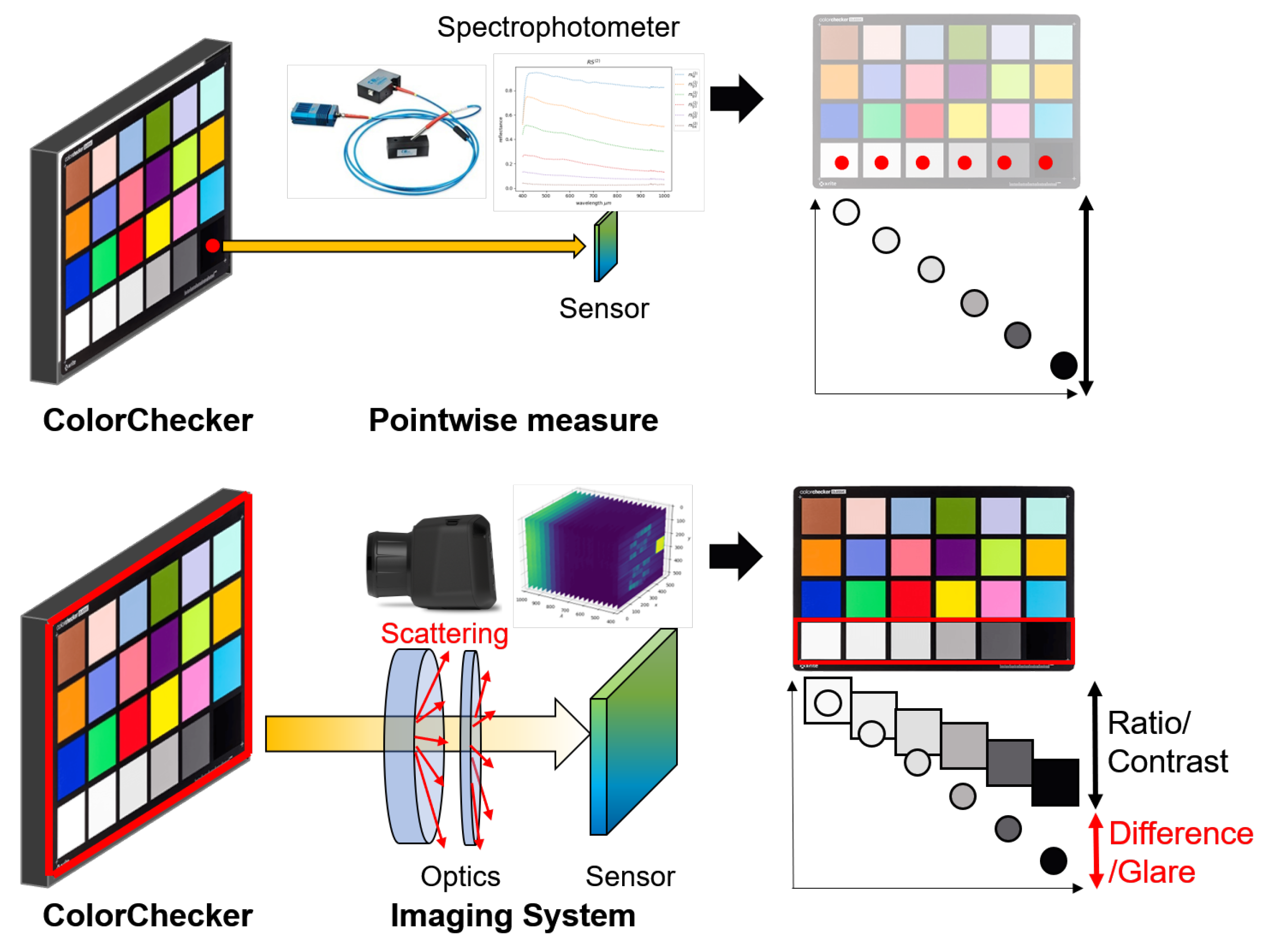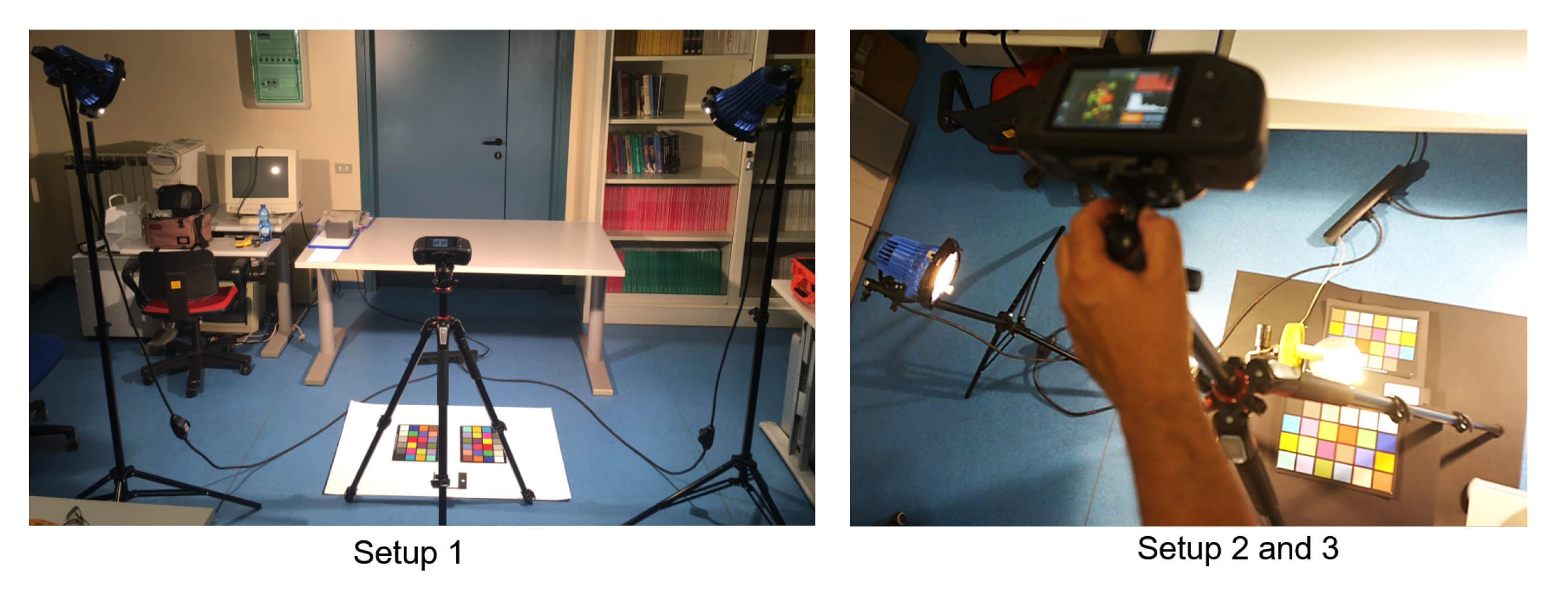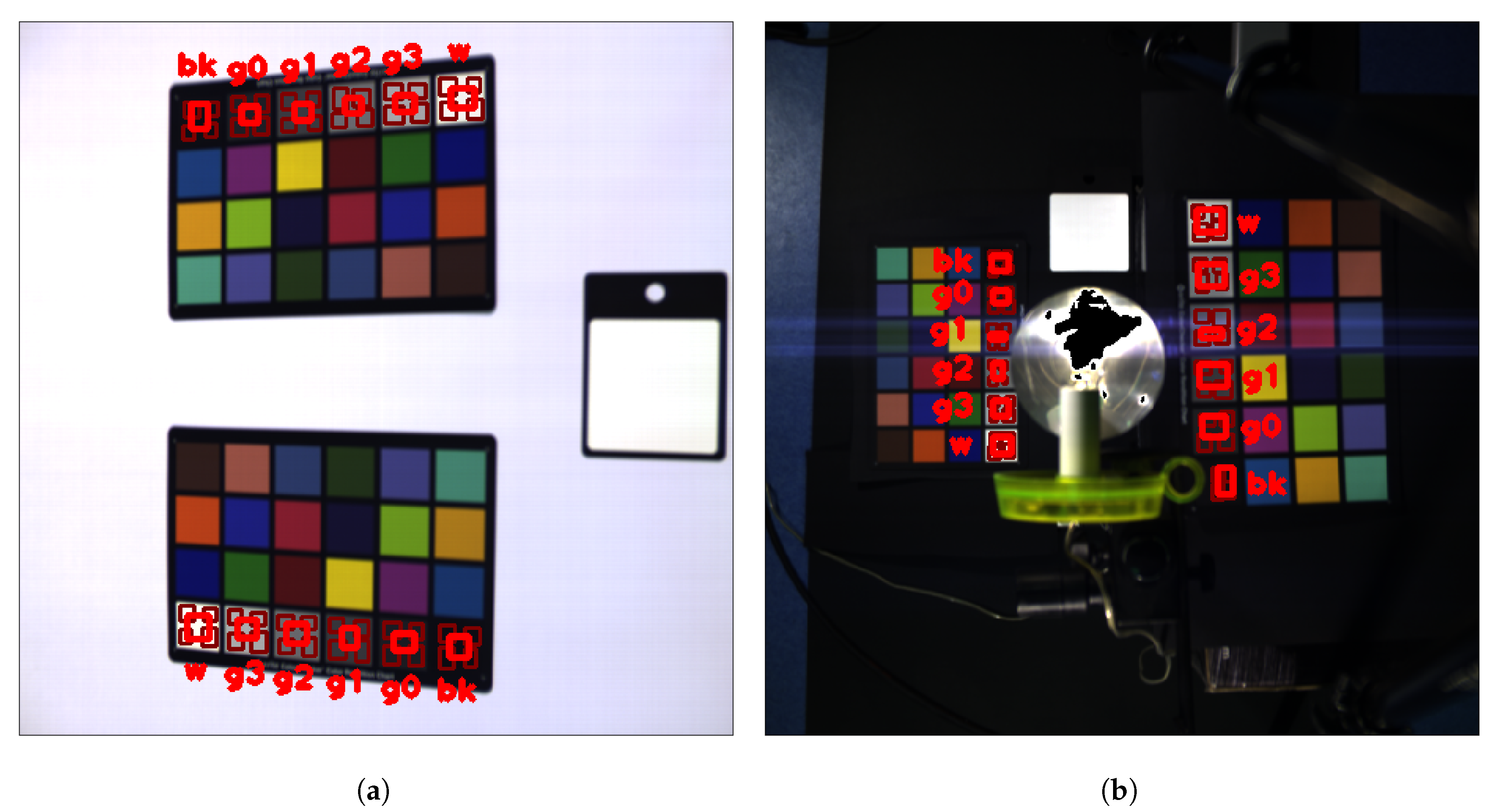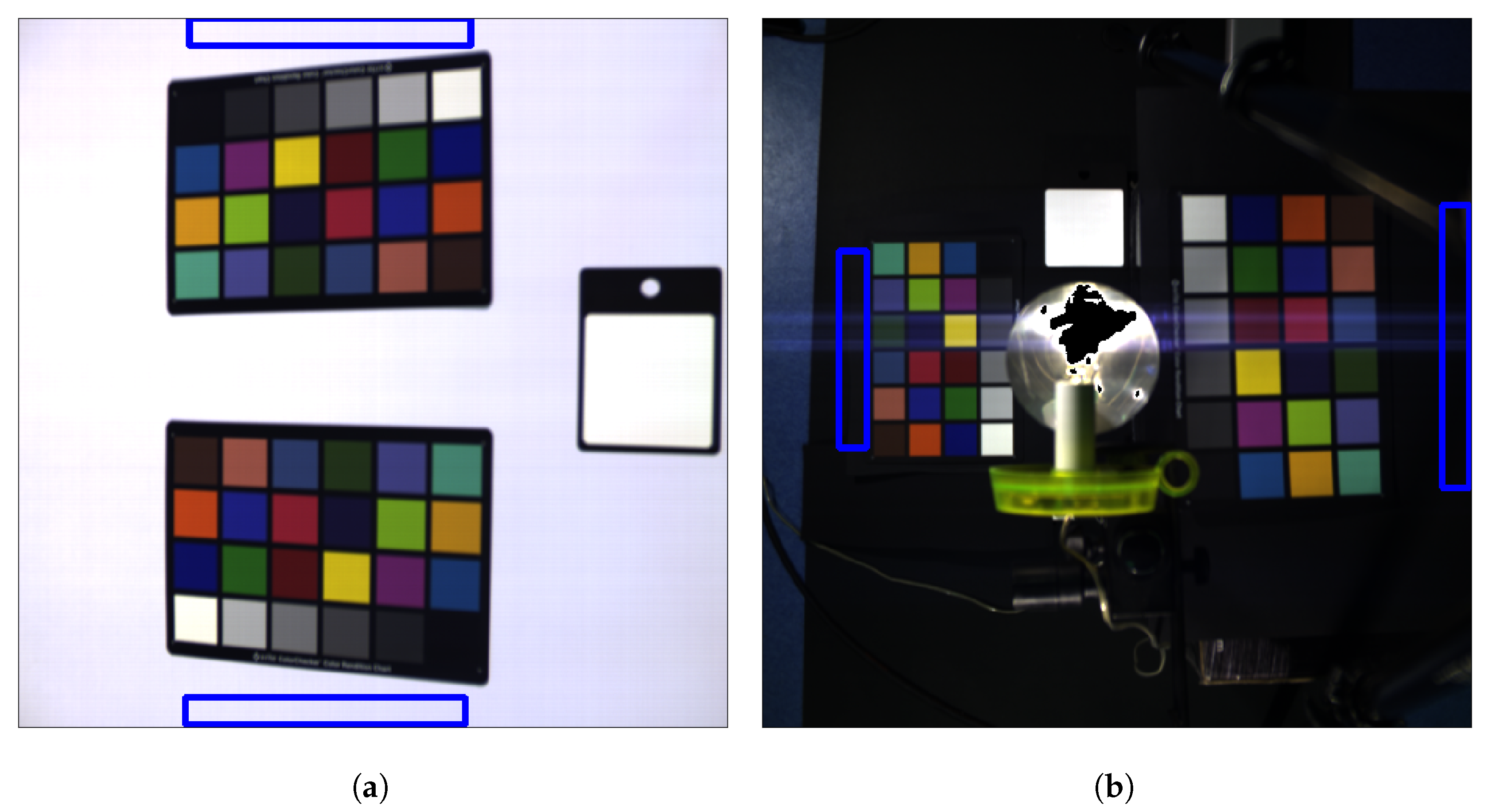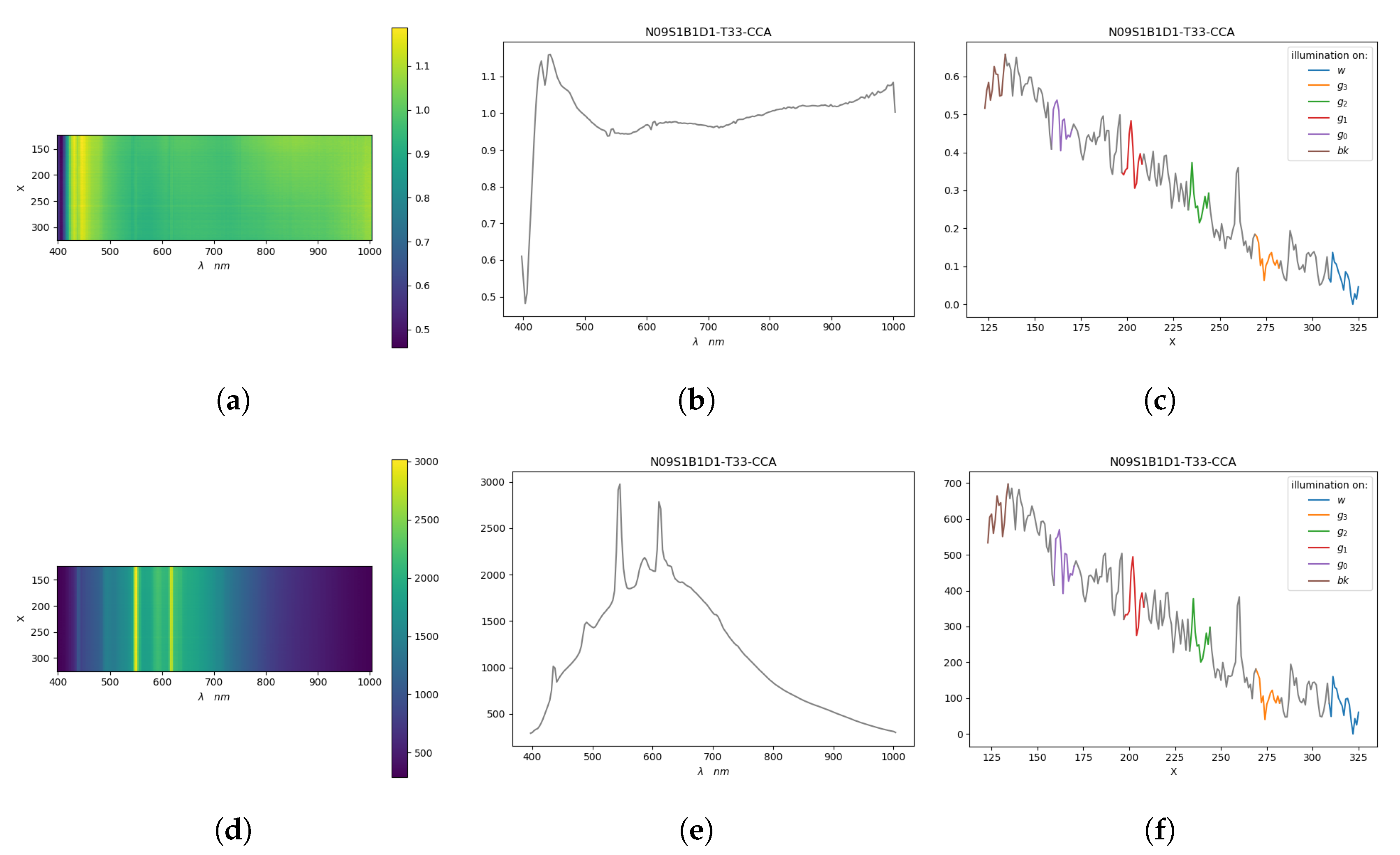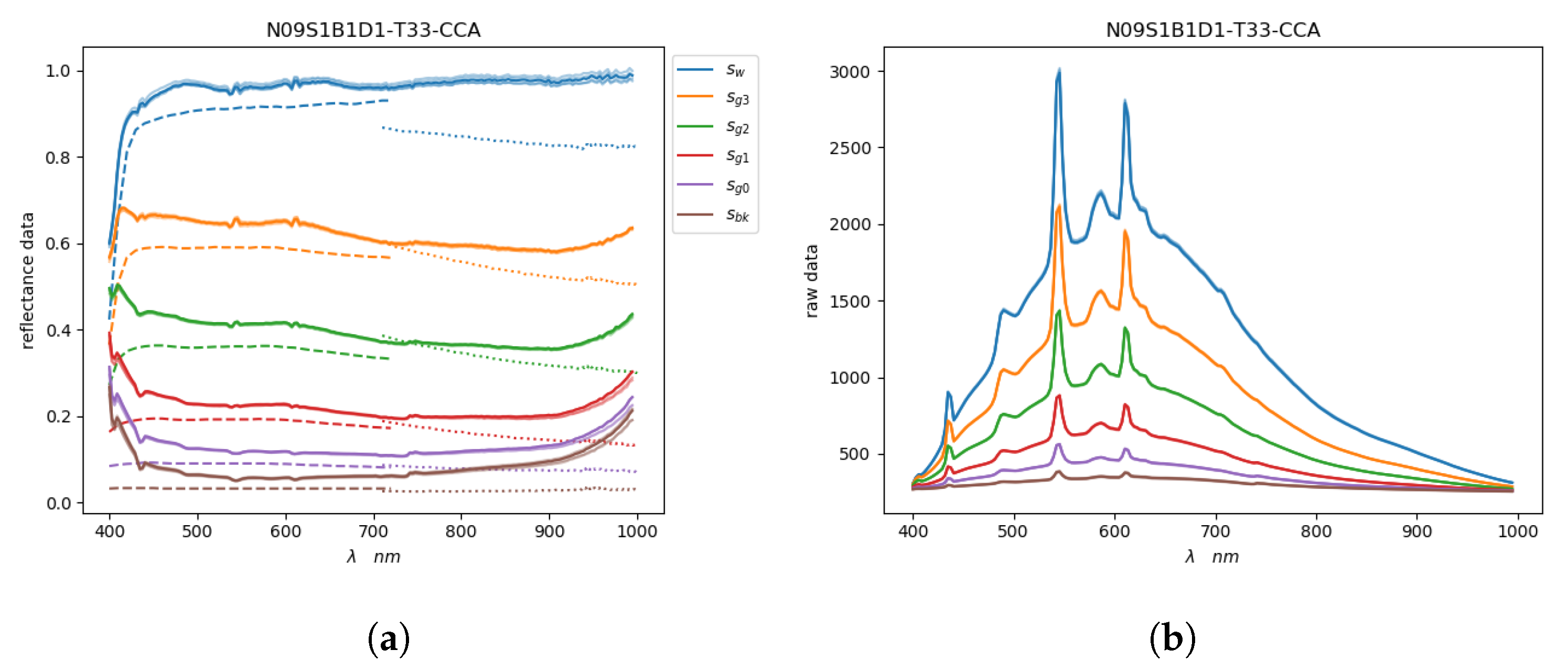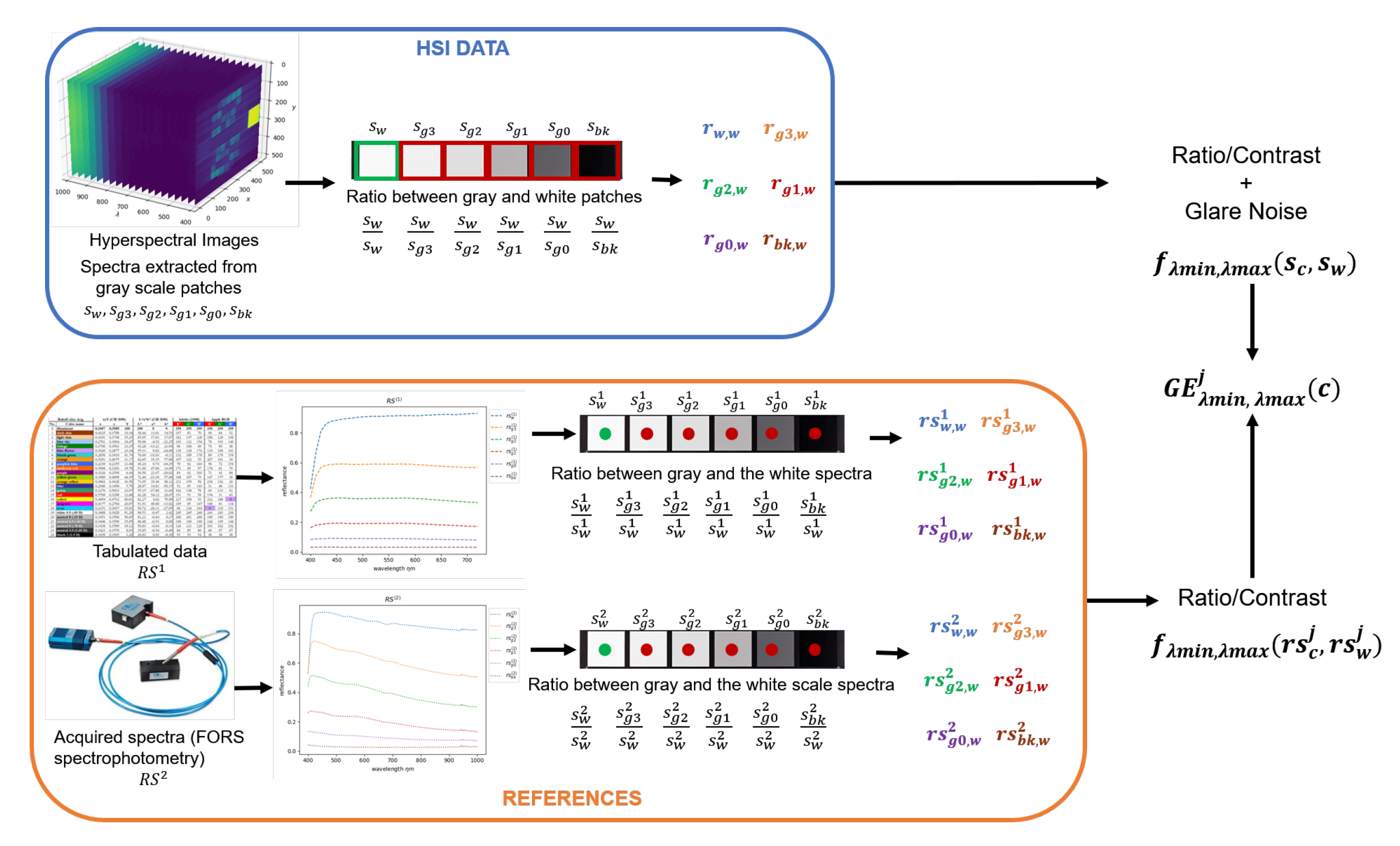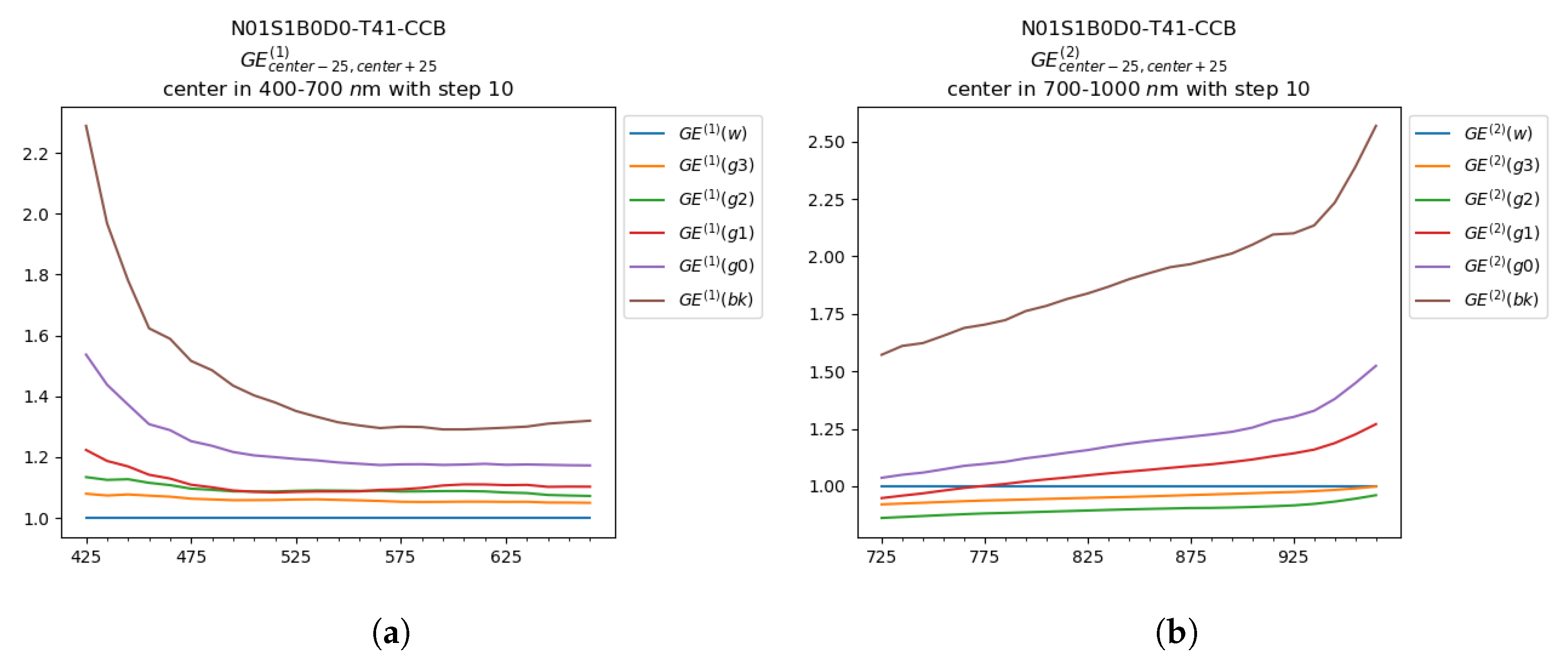For the values of Glare Evidence, as explained in the previous section, we expected increasing values going from ‘w’ to ‘bk’ with a minimum value of 1 for the white patch ‘w’ and the highest value for the black patch ‘bk’. The results of the first setup (‘S1’) were analyzed and discussed in
Section 4.1 and reported in
Table 5 and
Table 6, where
and
are considered respectively for the images with exposure time of 41
. In this section, in
Table 7 the results obtained through different exposure times are analyzed. The results of the second (‘S2’) and third setup (‘S3’) are discussed in
Section 4.2. The results of the second setup are reported in
Table 8 and
Table 9, where are considered
and
for images with exposure time of 44, 42 and 11 ms. The
values in the third setup are computed from images acquired with exposure time of 21 and 11 ms, and the results are reported in
Table 10 and
Table 11. In
Section 4.3 we provide results and considerations about spectral GE behaviors.
4.1. Setup 1
In this section the comparison between the reference reflectance values of the ColorChecker and the reflectance measured through HSI are reported. Here we focus on the first setup (‘S1’), where the CCs have been acquired with a black (‘B0’) or white (‘B1’) background, with an exposure time of 41 (‘T41’). The Glare Effect in the visible range () has been measured using as reference :
Table 5.
.
Table 5.
.
| HSI Number | w | g3 | g2 | g1 | g0 | bk |
|---|
| N01S1B0D0-T41-CCA | 1.00 | 0.99 | 1.01 | 0.98 | 1.02 | 1.29 |
| N01S1B0D0-T41-CCB | 1.00 | 1.06 | 1.10 | 1.13 | 1.27 | 1.56 |
| N02S1B0D1-T41-CCA | 1.00 | 1.04 | 1.08 | 1.10 | 1.22 | 1.52 |
| N02S1B0D1-T41-CCB | 1.00 | 1.03 | 1.01 | 0.98 | 1.05 | 1.28 |
| N07S1B1D1-T41-CCA | 1.00 | 1.04 | 1.11 | 1.18 | 1.42 | 2.22 |
| N07S1B1D1-T41-CCB | 1.00 | 1.03 | 1.04 | 1.06 | 1.25 | 1.90 |
| N08S1B1D0-T41-CCA | 1.00 | 1.00 | 1.03 | 1.04 | 1.18 | 1.80 |
| N08S1B1D0-T41-CCB | 1.00 | 1.07 | 1.12 | 1.19 | 1.43 | 2.14 |
The Glare Effect in the IR range () has been measured using as reference :
Table 6.
.
Table 6.
.
| HSI Number | w | g3 | g2 | g1 | g0 | bk |
|---|
| N01S1B0D0-T41-CCA | 1.00 | 0.87 | 0.81 | 0.87 | 0.95 | 1.55 |
| N01S1B0D0-T41-CCB | 1.00 | 0.96 | 0.91 | 1.08 | 1.23 | 2.02 |
| N02S1B0D1-T41-CCA | 1.00 | 0.92 | 0.90 | 1.02 | 1.20 | 2.01 |
| N02S1B0D1-T41-CCB | 1.00 | 0.91 | 0.82 | 0.91 | 0.98 | 1.58 |
| N07S1B1D1-T41-CCA | 1.00 | 0.94 | 0.95 | 1.16 | 1.49 | 2.98 |
| N07S1B1D1-T41-CCB | 1.00 | 0.93 | 0.87 | 1.05 | 1.28 | 2.49 |
| N08S1B1D0-T41-CCA | 1.00 | 0.88 | 0.85 | 0.97 | 1.17 | 2.27 |
| N08S1B1D0-T41-CCB | 1.00 | 0.97 | 0.95 | 1.19 | 1.46 | 2.82 |
The
values in the visible range, reported in
Table 5, increased as expected along the grayscale and the blacks are the patches with highest values, with the only exception of the CCB in ‘N02’. In this setup, it was possible to notice that the presence of glare in the images grew considerably when the black patches were near the white reference or in the condition with the white background.
We remind to the reader that the images were acquired with a black (‘B0’) or a white (‘B1’) background, and that the CCs could be displayed horizontally with both the grayscales toward the center of the image (‘D0’) or toward the borders of the image (‘D1’). Thus, looking at the
values of
Table 5 we can notice that in ‘B1’ conditions the values of ‘g3’, ‘g2’ and ‘g1’ had similar values than in condition ‘B0’, but the values of ‘g0’ and ‘bk’ were considerably higher.
Furthermore, we can notice that ‘N07-CCA’ and ‘N08-CCB’ presented the black patches with the highest values. In this case, both the CC were displayed on a white background and with the black patches toward the left border of the image. It can be noticed that the black patches in this area of the image, presented the highest values of . This effect could be caused by an irregular light distribution, which was more intense on the left side of the image. This condition contributed to producing a higher glare, especially with a white background which caused in ‘N07-CCA’ and ‘N08-CCB’ the highest values of . Notwithstanding the influence of the light distribution in the left region, it is fundamental to notice that this effect just increased the glare, which however affected all the measured black patches, also in the CC with ‘bk’ patch oriented toward the opposite direction.
In the IR range, reported in
Table 6, the trend of the data was similar to the visible range. In the IR range, the incongruity and mismatch problems of the reference spectra were more visible, which caused the decrease of GE values under 1. Despite this problem, also in the IR range the black patch presented considerably higher values of
, which in most cases grew over 2 (meaning over 100% values alteration). Also in this range of wavelengths, ‘N07-CCA’ and ‘N08-CCB’ presented the highest GE values and the data trend was the same as in the visible range.
In
Table 5 and
Table 6 we considered an exposure time of 41
, which was empirically defined as the more suitable for the setup 1. To support this decision we report here the
values obtained acquiring an image in the same conditions of setup, background and direction, through different exposure times (‘T41’, ‘T33’, ‘T14’):
Table 7.
.
Table 7.
.
| HSI Number | w | g3 | g2 | g1 | g0 | bk |
|---|
| N01S1B0D0-T41-CCA | 1.00 | 0.99 | 1.01 | 0.98 | 1.02 | 1.29 |
| N01S1B0D0-T41-CCB | 1.00 | 1.06 | 1.10 | 1.13 | 1.27 | 1.56 |
| N03S1B0D0-T33-CCA | 1.00 | 0.99 | 1.00 | 0.97 | 1.02 | 1.28 |
| N03S1B0D0-T33-CCB | 1.00 | 1.06 | 1.10 | 1.12 | 1.26 | 1.58 |
| N05S1B0D0-T14-CCA | 1.00 | 0.99 | 1.00 | 0.97 | 1.03 | 1.30 |
| N05S1B0D0-T14-CCB | 1.00 | 1.05 | 1.09 | 1.12 | 1.27 | 1.57 |
The
values in
Table 7 showed that changing the exposure time, the results were nearly unchanged, with an average variance of 0.02.
4.2. Setup 2 and 3
In this section are reported the Glare Effect values for the setup 2 (‘S2’) and the setup 3 (‘S3’). In this case, all the hyperspectral images have been acquired with a black background (‘B0’) and the ColorCheckers have been disposed vertically over the two main directions ‘D0’ and ‘D1’. We remind to the reader that in setup 2 the acquisitions have been made with an LED lamp between the two CCs and in setup 3 without the lamp. Considering the setup 2, the Glare Effect in the visible range () has been measured using as reference :
Table 8.
.
Table 8.
.
| HSI Number | w | g3 | g2 | g1 | g0 | bk |
|---|
| N13S2B0D1-T44-CCA | — | — | — | — | — | — |
| N13S2B0D1-T44-CCB | — | — | — | — | — | — |
| N14S2B0D0-T42-CCA | — | — | — | — | — | — |
| N14S2B0D0-T42-CCB | 1.00 | 1.19 | 1.78 | 1.54 | 1.86 | 2.37 |
| N15S2B0D0-T42-CCA | — | — | — | — | — | — |
| N15S2B0D0-T42-CCB | — | — | — | — | — | — |
| N16S2B0D0-T42-CCA | — | — | — | — | — | — |
| N16S2B0D0-T42-CCB | — | — | — | — | — | — |
| N17S2B0D0-T11-CCA | 1.00 | 1.05 | 1.07 | 1.63 | 1.29 | 1.76 |
| N17S2B0D0-T11-CCB | 1.00 | 0.96 | 1.57 | 1.44 | 1.82 | 2.37 |
| N18S2B0D0-T11-CCA | 1.00 | 1.07 | 1.12 | 1.59 | 1.60 | 2.61 |
| N18S2B0D0-T11-CCB | 1.00 | 0.99 | 1.57 | 1.63 | 2.24 | 3.48 |
| N19S2B0D1-T11-CCA | 1.00 | 1.05 | 1.17 | 1.15 | 1.25 | 1.59 |
| N19S2B0D1-T11-CCB | 1.00 | 1.08 | 1.16 | 1.36 | 1.30 | 1.70 |
| N20S2B0D1-T11-CCA | 1.00 | 1.03 | 1.13 | 1.09 | 1.19 | 1.55 |
| N20S2B0D1-T11-CCB | 1.00 | 1.07 | 1.15 | 1.29 | 1.29 | 1.65 |
| N21S2B0D1-T11-CCA | 1.00 | 1.03 | 1.07 | 1.09 | 1.18 | 1.55 |
| N21S2B0D1-T11-CCB | 1.00 | 1.06 | 1.12 | 1.15 | 1.22 | 1.59 |
and the Glare Effect in the IR range () has been measured using as reference :
Table 9.
Table 9.
| HSI Number | w | g3 | g2 | g1 | g0 | bk |
|---|
| N13S2B0D1-T44-CCA | — | — | — | — | — | — |
| N13S2B0D1-T44-CCB | — | — | — | — | — | — |
| N14S2B0D0-T42-CCA | — | — | — | — | — | — |
| N14S2B0D0-T42-CCB | 1.00 | 1.08 | 1.89 | 1.56 | 1.89 | 2.91 |
| N15S2B0D0-T42-CCA | — | — | — | — | — | — |
| N15S2B0D0-T42-CCB | — | — | — | — | — | — |
| N16S2B0D0-T42-CCA | — | — | — | — | — | — |
| N16S2B0D0-T42-CCB | — | — | — | — | — | — |
| N17S2B0D0-T11-CCA | 1.00 | 0.96 | 0.92 | 2.01 | 1.35 | 2.33 |
| N17S2B0D0-T11-CCB | 1.00 | 0.86 | 1.74 | 1.47 | 1.89 | 2.90 |
| N18S2B0D0-T11-CCA | 1.00 | 1.01 | 1.08 | 2.05 | 2.31 | 5.05 |
| N18S2B0D0-T11-CCB | 1.00 | 0.96 | 1.71 | 1.98 | 3.11 | 6.34 |
| N19S2B0D1-T11-CCA | 1.00 | 0.96 | 1.05 | 1.18 | 1.28 | 2.01 |
| N19S2B0D1-T11-CCB | 1.00 | 0.95 | 0.97 | 1.41 | 1.30 | 2.12 |
| N20S2B0D1-T11-CCA | 1.00 | 0.94 | 0.97 | 1.09 | 1.20 | 1.99 |
| N20S2B0D1-T11-CCB | 1.00 | 0.95 | 0.95 | 1.24 | 1.25 | 2.00 |
| N21S2B0D1-T11-CCA | 1.00 | 0.93 | 0.91 | 1.07 | 1.19 | 1.99 |
| N21S2B0D1-T11-CCB | 1.00 | 0.94 | 0.93 | 1.05 | 1.16 | 1.91 |
As reported in
Table 8 and
Table 9 in the second setup have been used different exposure times. In fact, the presence of an LED lamp between the two CC caused the saturation of the camera sensors for exposure times over 11, with just one exception (‘N14-CCB’).
Additionally in this setup, as in ‘S1’ presented in the previous section, all the values increased along the grayscale, and the black patch presented the highest values in all the CCs. In this setup, the main differences were caused by the changes in the orientations of the CCs. In fact, in the condition ‘D0’, where both the grayscales of ColorChecker A and B were near the LED lamp, we had the highest values of (i.e., ‘N17’ and ‘N18’) and the highest values of glare were registered for the ‘bk’ patches of ‘CCA’ and ‘CCB’ in the image ‘N18’. Thus, the proximity to the LED lamp caused a strong increase of glare in the darkest patches, as expected.
In addition to this consideration, it must be noticed that, also in this case, the increase of could be observed also in the condition ‘D1’, where the grayscale was toward the borders (e.g., distant from the lamp), so the glare spread to a varying extent in all the regions of the image.
The values of Glare Effect in the IR range are reported in
Table 9. Additionally in this case the data trend was coherent with the visible range, and the highest
values were registered for images ‘N17’ and ‘N18’, where the CCs grayscale was placed near the LED lamp. In this case, in ‘N18’ the black patches reached values of 5.05 and 6.34.
Now, considering the setup 3, the Glare Effect in the visible range () has been measured using as reference:
Table 10.
.
Table 10.
.
| HSI Number | w | g3 | g2 | g1 | g0 | bk |
|---|
| N22S3B0D1-T21-CCA | 1.00 | 1.02 | 1.03 | 1.07 | 1.17 | 1.49 |
| N22S3B0D1-T21-CCB | 1.00 | 1.05 | 1.12 | 1.04 | 1.14 | 1.48 |
| N23S3B0D1-T11-CCA | 1.00 | 1.03 | 1.04 | 1.07 | 1.16 | 1.50 |
| N23S3B0D1-T11-CCB | 1.00 | 1.03 | 1.09 | 1.04 | 1.14 | 1.44 |
and the Glare Effect in the IR range () has been measured using as reference:
Table 11.
.
Table 11.
.
| HSI Number | w | g3 | g2 | g1 | g0 | bk |
|---|
| N22S3B0D1-T21-CCA | 1.00 | 0.93 | 0.86 | 1.04 | 1.16 | 1.89 |
| N22S3B0D1-T21-CCB | 1.00 | 0.93 | 0.92 | 0.92 | 1.09 | 1.78 |
| N23S3B0D1-T11-CCA | 1.00 | 0.93 | 0.87 | 1.04 | 1.16 | 1.92 |
| N23S3B0D1-T11-CCB | 1.00 | 0.91 | 0.90 | 0.93 | 1.09 | 1.74 |
As reported in
Table 10 and
Table 11, in setup 3 two exposure times were used, ‘T21’ and ‘T11’, which produced almost identical results. Additionally in this setup, the Glare Effect grew along the grayscale and the black patches were the ones that reported the highest values. Thanks to these measures we could compare the values of setup 2 with the images obtained in the same conditions but without the LED lamp and determined that glare was not caused just by the light source but remained also in this condition. More specifically, considering the results in the visible range reported in
Table 10, it was possible to see that glare was present also without a white background or an intense light source in the image (as seen in setup1 with ‘B0’). In fact, the presence of a white patch was sufficient to affect with glare all the image, causing an increase of the black reflectance of 1.50 circa.
4.3. Glare Spectral Analysis
In this Section we present a first outlook at the glare spectral trend. The plots in
Figure 10 and
Figure 11 represents
values for the wavelengths in the visible range (
Figure 10a and
Figure 11a) and the
values in the IR range (
Figure 10b and
Figure 11b), with a step of 10 nm. In each plot are reported the
values for each grayscale patch.
Considering
Figure 10, the Glare Effect was computed from the data coming from the ColorChecker B in the first setup (‘S1’), with black background (‘B0’) and with the grayscale toward the center of the hyperspectral image (‘D0’). Considering the visible range (
Figure 10a), the values of
were higher in short wavelengths (blue-violet portion of the visible spectrum), especially in the ‘bk’ and ‘g0’ patches, and its trend was statistically comparable in all the other wavelengths. Considering the
values in the IR range (
Figure 10b), the Glare Effect increased significantly in the portion of the spectrum from 900 to 1000 nm and ‘bk’ was significantly higher in intensity than the other patches. Nevertheless, the mismatch between the acquired spectra and
affected significantly the reliability of the outcomes, which resulted in the decrease of many
values under 1 (e.g., patches ‘g3’ and ‘g2’ in
Figure 10b). In
Figure 11 the spectral Glare Effect trend was analyzed for the CCB, acquired in the second setup (‘S2’), with black background (‘B0’) and with the grayscale in proximity to the LED lamp in the scene (‘D0’). As in the previous case, the values of
were higher for shorter wavelengths, but in this condition, the spectral trend was less smooth and presented a peak around 580 nm (in correspondence with the first peak of the raw data,
Figure 7b). Considering the
values in the IR range, also in this case an increase of
values was registered over 900 nm. In both the considered conditions, the glare trend was similar, with a growth in the shortest and in the longest wavelengths. Furthermore, it was clearly visible that the presence of the LED in the second setup, increased all the
values in intensity, but the general shape was similar. An interesting difference between the two setups was reported in the patch ‘g2’, which overcame in intensity the patch ‘g1’ in ‘N14-S2’ also if it was lighter, and seemed more affected by the increase in intensity at the limits of the spectral range (below 470 nm and over 900 nm). From the glare spectral analysis, we can deduce that the Glare Effect presented some differences in specific wavelengths regions, but this could be caused by different factors like mismatches between the reference and the acquired spectra, or approximation errors during the normalization procedures. Thus, the analysis of glare spectral trend deserves further attention and research.
